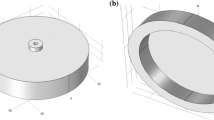Abstract
An aluminum split Hopkinson pressure bar is instrumented with quartz force transducers and used to test low impedance materials. Two transducers are used, one at the interface between the specimen and the incident bar and the other at the interface between the specimen and the transmitter bar. It is shown that the stress measured by the incident bar gage often contains a substantial acceleration component, i.e., a significant portion of the signal recorded by the gage is due to its own inertia and not representative of the stress within the sample. Attempts are made to actively compensate for this with measurements of the acceleration of the gage. This is done in three ways: (i) by differentiation of the interface velocity, as determined by a standard strain gage analysis; (ii) by a more direct determination of acceleration, using a measurement of the strain gradient within the bar; (iii) by adding a compensation crystal and mass to the gage to remove the inertial component from the output. It is shown that all three techniques successfully mitigate inertial effects.
Similar content being viewed by others
References
Graham, R.A.. “Technique for Studying Piezoelectricity Under Transient High Stress Conditions,”Review of Scientific Instruments,32,1308–1313 (1961).
Karnes, C.H. andRipperger, E.A., “Strain Rate Effects in Cold Worked High-purity Aluminum”,Journal of the Mechanics and Physics of Solids,14,75–88 (1966).
Chalupnik, J.D. andRipperger, E.A., “Dynamic Deformation of Metals Under High Hydrostatic Pressure,” EXPERIMENTAL MECHANICS.6,547–554 (1966).
Wasley, R.J., Hoge, K.G., andCast, J.C., “Combined Strain Gauge-Quartz Crystal Instrumented Hopkinson Split Bar,”Review of Scientific Instruments,40,889–894 (1969).
Togami, T.C., Baker, W.E., andForrestal, M.J., “A Split Hopkinson Bar Technique to Evaluate the Performance of Accelerometers,”Journal of Applied Mechanics,63,353–356 (1996).
Chen, W., Lu, F., andZhou, B., “A Quartz-crystal-embedded Split Hopkinson Pressure Bar for Soft Materials,” EXPERIMENTAL MECHANICS,40,1–7 (2000).
Chen, W., Lu, F., andWinfree, N.A., “Dynamic Compressive Response of Polyurethane Foams of Various Densities,” EXPERIMENTAL MECHANICS,42(1),65–73 (2002).
Chen, W., Lu, F., Frew, D.J., andForrestal, M.J., “Dynamic Compression Testing of Soft Materials,”Transaction of the ASME, Journal of Applied Mechanics,69(3),214–223 (2000).
Follansbee, P.S. andFrantz, C., “Wave Propagation in the SHPB,”Transactions of the ASME, Journal of Engineering Materials and Technology,105,61–66 (1983).
Lifshitz, J.M., andLeber, H., “Data Processing in the Split Hopkinson Pressure Bar Tests,”International Journal of Impact Engineering,15,723–733 (1994).
Bacon, C., “An Experimental Method for Considering Dispersion and Attenuation in a Viscoelastic Hopkinson Bar,” EXPERIMENTAL MECHANICS.38,242–249 (1998).
Gong, J.C., Malvern, L.E., andJenkins, D.A., “Dispersion Investigation in the Split Hopkinson Pressure Bar,”Transactions of the ASME, Journal of Engineering and Material Technology,112,309–314 (1990).
Bickle, L., “The Response of Strain Gages to Longitudinally Sweeping Strain Pulses,” EXPERIMENTAL MECHANICS,10 (8),333–337 (1970).
Author information
Authors and Affiliations
Rights and permissions
About this article
Cite this article
Casem, D., Weerasooriya, T. & Moy, P. Inertial effects of quartz force transducers embedded in a split Hopkinson pressure bar. Experimental Mechanics 45, 368–376 (2005). https://doi.org/10.1007/BF02428167
Received:
Accepted:
Issue Date:
DOI: https://doi.org/10.1007/BF02428167




